
Check out the 6 volunteer projects below for a dose of giving back inspiration. We had a chance to sit and chat with each organization about their mission, their progress, and how you can join forces with them to make a difference. Whether you want to help bring education and creativity to local children, or aid in the development of recycling, eco-agriculture, and clean water in local villages, there is an opportunity awaiting.
Otra Cosa is an NGO with the mission of extending educational opportunities and social development programs to residents of low-income communities in Huanchaco, Peru and surrounding areas. The NGO has been serving the community since 2004, and currently has five active projects, all of which are part of the Huanchaco Education and Learning Programme (HELP). The projects include HELP Youth, HELP Literary, HELP Women, HELP Environment, and HELP English.
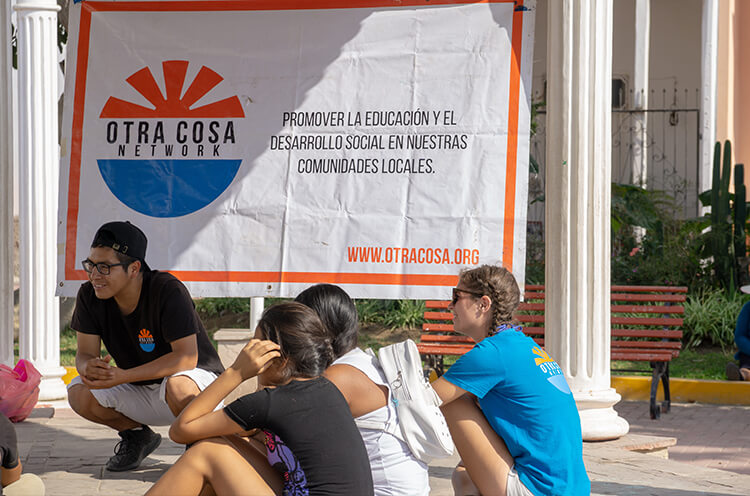
Let’s take a closer look at one of these programs. HELP Environment is all about providing local solutions to global environmental issues. This project has two main focuses: one being environmental education and the other being direct action to transform Huanchaco into a cleaner, greener place. The education side is dedicated to inspiring people of all ages to care for their local environment. There are beach clean-up projects, climate change workshops, and even hydroponic gardening classes. The direct impact side includes promoting and establishing organic waste recycling, composting, vermiculture access, local wetland conservation, and more.
Within this program, and the others, there are both volunteer and internship opportunities. Once selected, the organization will help arrange affordable, long-term housing as well as provide general and emergency support. The NGO is based in the Huanchaco/Trujillo area on the coast of Northern Peru, with two more remote locations further north. Otra Cosa Network is a registered Peruvian nonprofit as well as a UK Registered Charity.
Otra Cosa is based in Huanchaco. Why here? What makes this coastal town so special?
Otra Cosa is based in Huanchaco although the majority of our placements take place in informal settlements surrounding this coastal town. These communities are primarily comprised of migrants from the highlands of Peru who have come here in search of a better quality of life or fleeing destruction caused by natural disasters such as the El Nino phenomenon. These communities have struggled to take advantage of the economic benefits that Huanchaco has to offer and although some families have been here for over 20 years, many still do not have access to running water or electricity and are surviving on a very low basic income.
Otra Cosa works with these communities to ensure equal access to accommodation for all and provide the children living there with the best possible start in life. Huanchaco is a great place for volunteers to visit as well, with some of the best surf in Peru, the famous Caballito de Totora boat and many fascinating pre-inca sites to visit nearby.
Could you describe the HELP Environment project you run?
HELP Environment has two primary focuses. The first and most important is Environmental education. We work closely with the younger generation local in Huanchaco and the surrounding areas with the hope of influencing their attitudes towards the environment, boosting their knowledge of large-scale environmental issues, and demonstrating how day-to-day behaviors can have a positive influence on their own environment. The second focus is on direct environmental impacts, participating in local campaigns and initiatives to protect the environment. The HELP Environment program runs in collaboration with local actors and is aimed at making Huanchaco a cleaner, more environmentally-sustainable place.
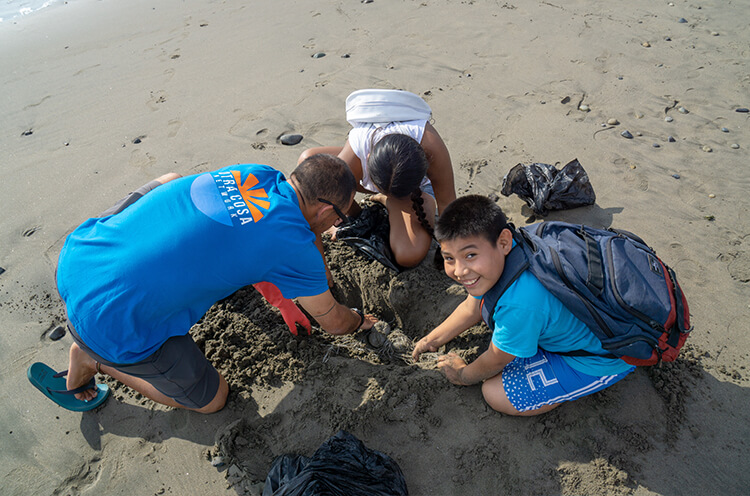
What are the actions you are taking?
We run environmental classes in three local primary schools as well as workshops in community spaces. We also have a community garden in Las Lomas where we teach children how to grow their own vegetables and look after different types of plants. We run a hydroponic gardens project where children grow vegetables and salads in hydroponic beds This method of cultivation requires less water than traditional gardening and therefore is a fantastic method here in Huanchaco where there is a very arid climate.
Could you describe in details the Yo Cuido mi Playa action?
Yo Cuido Mi Playa is a project which focuses on taking care of the local beach. Once a month we hold environmental activities and games for children next to the beach. After these activities volunteers accompany the children to the beach in order to clean the litter that has been left there. This initiative aims to raise awareness about the importance of the beach in Huanchaco and the dangers of litter to the local marine life.
For this program, what sorts of tasks do volunteers help out with?
Volunteers are responsible for planning and delivering environmental classes and workshops. They need to be able to interact with the local children and inspire them to look after their environment. Volunteers also look after the community garden that we manage as well as run composting and recycling programs from the volunteer house.
Is there a specific story that you can share with us?
This year Otra Cosa Network partnered with Sodimac, a Peruvian hardware store to run two beach cleans in Huanchaco. This was a great opportunity for the HELP Environment volunteers to work with local people in an effort to clean the beaches of Huanchaco. People were required to collect litter from the beach in groups and were rewarded with points for different items (depending on how dangerous they were for the environment). They could then exchange these points for different items sold at Sodimac including tents, airbeds, reusable cups and bags etc. It was great to see people getting involved in this initiative and working together to keep the beach clean.
What exciting news does Otra Cosa have to share about any 2020 projects or plans in Huanchaco?
We are looking to expand our hydroponic gardening project in 2020 to be able to work with more schools and more students. Currently we have 8 hydroponic beds in one school in Huanchaquito (an informal settlement on the outskirts of Huanchaco) but we hope to expand this to work in another two schools as well as in some community spaces. We will work in collaboration with students from the National University of Trujillo as well as with the local municipality in order to expand and develop this project and teach more students about the benefits of hydroponic gardening.
Price: From $309
Min commitment: 2 weeks
Where: Huanchaco, Trujillo, Peru
Volunteer
Maximo Nivel was founded in 2003 and is an internationally accredited organization with institutes in Peru, Guatemala, and Costa Rica. The organization provides study abroad, education travel, and volunteer opportunities, in addition to international internships, TEFL certifications, and Spanish immersion experiences.
One of the volunteer offerings is an Indigenous Immersion program. Volunteers are given the opportunity to work and live with an indigenous family. This means getting a firsthand view into the low-impact, sustainable, and high quality ways of life in longstanding native villages.
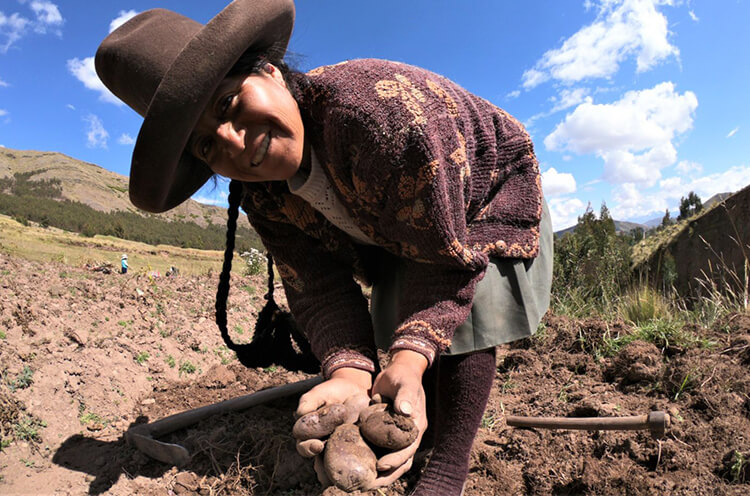
The Andean immersion project, for example, is located in the Peruvian Andes, just 1 hour from Cusco. Here, volunteers are placed in an indigenous, Quechua-speaking community and live and work with a traditional Andean family. Tasks may include raising corn and potatoes, herding sheep and cows, light construction, working with kids at the local school, or traditional weaving. Work can vary depending on the needs and time of year, and volunteers are expected to work 4-6 hours a day Monday through Friday.
The experience comes complete with airport pick-up, host family accommodation in a shared room, breakfast and dinner 7 days a week, official certificate of volunteer service, letter of recommendation, and a 24/7 emergency contact number. Keep in mind that, as it is an immersion program, projects are typically off the grid with limited internet. Also bear in mind that there may be some cultural differences, in particular in the division of labor by gender, and as a visitor you are expected to fully respect and adhere to these traditions.
For how long has your organization been working in Cusco?
Maximo Nivel was founded in Cusco, Peru and we have been operating in this community for almost 18 years.
How many programs do you offer in the region?
At the moment, we have approximately 120-140 projects running at any given time. These programs are quite diverse and each serve the community according to their needs.
I’d love to hear more about the Andean cultural immersion you offer! Could you tell me more about it?
Yes, our Andean Immersion project is one of our most popular projects. It allows our clients to live with a family in the Andean highlands and live, eat, and work as they do. The difference is drastic compared to more developed countries and it allows our volunteers to learn and experience life in a more simple way, where the families utilize what they have around them to build their homes, produce clothing and textiles, and put food on the table. Participants work with the families daily in the fields, preparing food, and producing textiles that are the general livelihood of most families in this region. Our immersion projects are without internet or television, so it also provides our clients the ability to unplug and appreciate a more simple life, where hard work within the family and small community are the most important aspects of their livelihood.
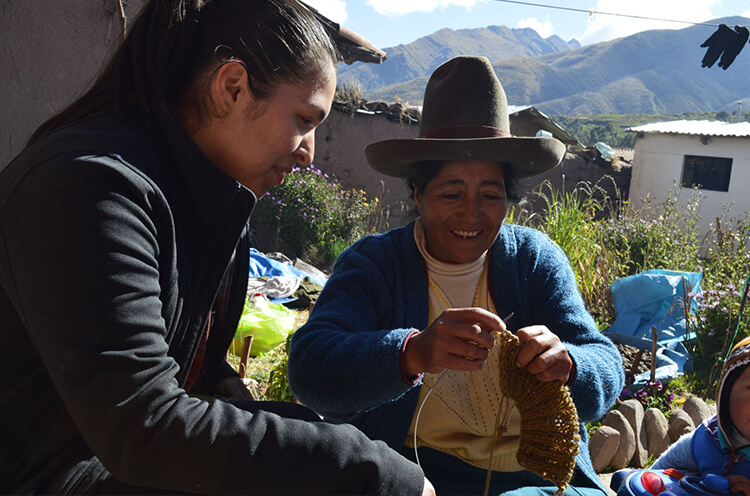
Volunteering for this specific project, what specific tasks and cultural interaction is involved?
Clients will work in the fields tending to animals as well as crops using handcrafted tools made from the materials found in the area. For those who want less intense labor, they are able to work with the shearing of sheep and alpaca and taking the raw product and turning it into beautiful textiles. These textiles can be used by the family, but can also be sold or traded at local markets to ensure the families have everything they need to survive and be comfortable. The families also offer optional Quechua lessons (for free), which is the indigenous language of the people in this region. In fact, many people in this region do not speak Spanish, only their native language.
What do your volunteers often say is their favorite part of being involved with this immersion?
The majority of our feedback is overwhelmingly positive. Clients really enjoy getting to know the families and being accepted into the families as if they were their own. They also really enjoy stepping away from the day-to-day stresses of computers, television, social media etc. They also enjoy the setting in which they are placed. The projects are located in the mountains walking distance from a beautiful lagoon. There are many opportunities for hiking, climbing or just finding a nice quiet place to reflect, write, draw or simply relax.
Do you have any favorite stories from any volunteering experiences that you would like to share with us?
My personal favorite story is that of a young lady who initially appeared quite high maintenance. She was very well-dressed and came from an affluent family. After one week, she was ready to leave the project so we sent one of our team members to meet with her and talk with her. She ultimately not only decided to stay, but extended for 6 more weeks. The family and the young lady are still in communication and she plans to visit again this summer. Sometimes it takes putting yourself outside your comfort zone to truly grow as a person, and she stated that this experience had taught her humility and respect for people that were unlike herself. To me, this is one of the most valuable lessons in life.
What do volunteers have to gain from working so closely with farmers from the Cusco region?
They gain perspective and the understanding that most of us from developed countries are fortunate to live in a very comfortable world. Here they learn that our life is not better than theirs and that these people take pride in the hard work it takes to survive and thrive in this environment. They gain humility and respect and also the understanding that it is possible to live within an environment without destroying it. They also get to know a group of people who are full of love and curiosity and welcome strangers into their homes to share their culture. For some, they also learn the value of a hard days work, and get to see the benefits immediately as they eat the freshly prepared food and cover in blankets that were made from the very beginning of shearing the sheep or alpaca.
Price: $645
Min commitment: 1 week
Where: 1 hour from Cusco
Volunteer
Proyecto Peru’s Organic Farming Project is located in a rural area, better known as the Cloud Forest, around four hours from the city of Cusco. This program is tailored to anyone that wants to have a hands-on experience in a small city with very few to no tourists.
In the area, people live off the production of coffee, tea, and other tropical fruits. Although they sell these products, they do not get too much extra in return. The mission of the program is to train and inform local farmers about how they can earn extra profits from their products, especially coffee and tea. The project teaches them how to process their products in a more organic way and also how to package them in order to sell them in the city of Cusco and/or abroad.
Our volunteers have different activities during the week, including days of harvest, roasting coffee, and packaging. They also take care of the tropical plants in the area, including passion fruit, pineapple, citrus, cassava, bananas, and more. Volunteers work Monday to Saturday 8am to 1pm, with time for fun leisure activities, like chocolate workshops, Peruvian cooking classes, and hikes to waterfalls or archaeological sites.
For how long has your organisation been working in Cusco?
Proyecto Peru started in December 2005 and was founded by Dora Elguera. She had the dream of helping her community by sending responsible volunteers to local projects. The focus of these projects are on social, health and education systems.
How many programs do you offer in the region?
Proyecto Peru currently offers 40 projects in 10 different programmes: Animal Care, Archaeological, Environmental, Healthcare, Youth & Development, Business, Education, Medical and Social Work.
I’d love to hear more about the Organic Farming Project you offer! Could you tell me more about it?
This project is located in the rural cloud forest of Cusco in the town of Huyro, the operations center is the Albergue Colibri and the biological station of the same name, the farmers of that poor area mainly live from the production of coffee, tea and other tropical products and sell it without being able to give it extra value. As most of the time, the producers have few economic benefits, while the intermediaries and the companies in the cities do. The mission of this project is to get farmers a little more profit from their products, especially organic coffee and tea by completing the whole artisanal process including packaging and selling in the larger market of Cusco and maybe other cities over time.
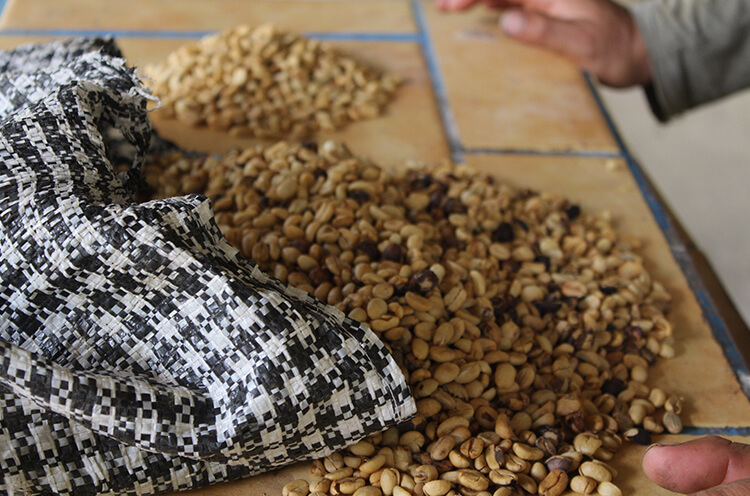
Volunteering for this specific project, what specific tasks and cultural interaction is involved?
Volunteers will have a balanced work day, combining days of harvest with days of drying, roasting and packaging of coffee and tea, as well as intervening in the care of other tropical plantations such as passion fruit, pineapple, a wide variety of citrus, cassava, bananas, ornamental plants and many others.
They will have a workshop on the cocoa process, Peruvian cooking lessons, and there is also the possibility for hikes to waterfall and archaeological attractions in the area. Community campaigns will be organised taking into account the need of the moment always ensuring the active participation of locals.
What do your volunteers often say is their favourite part of being involved with this immersion?
Our volunteers really like to experience the Peruvian culture and reflect them on their own.
What do volunteers have to gain from working so closely with farmers from the Cusco region?
They have to immerse themselves in a Peruvian community, which gives them the best insight in to their way of living. It gives them more knowledge on local food and other biological aspects.
Do you have any favourite stories from any volunteering experiences that you would like to share with us
We had one volunteer from the United States who wrote: ‘’I would highly recommend using Proyecto Peru for anything that you seek to do in Cusco. Whether that is staying somewhere with a family, being placed in an internship, or taking Spanish lessons with them you will not be disappointed with your experience. They have very fun staff members who will provide fantastic support for you, and great ways for you to experience Cusco outside of your project such as Thursday activity nights.’’ This is the kind of customer satisfaction we would like to achieve. Making stays of volunteers and interns unforgettable.
Is there any success story you would like to talk about?
I have saved the answer to this question for last. One of the company’s goals is to help families in the Cusco community obtain extra income by hosting travelers. Another goal is to give our travelers a cross-cultural, giving, and rewarding experience. In this success story of Proyecto Peru, a Peruvian family was able to send her daughter to university with the money they earned from the travellers immersing in the Peruvian community. It is a win-win situation.
Price: $1110
Min commitment: 4 weeks
Where: 4 hours from Cusco
Volunteer
Peru Volunteer is a Peru-based volunteer organization, started in 2013. The mission of the organization is to help support local community development in Peru with the aid of volunteers from across the globe. All projects are located in and around Cusco, and are easily reachable by public transport. Focus areas include english classes, physical education, kindergarten, special education, dog shelter campaigns, and water filter installation.
The water filter project is in its beginning phases, and the mission is to provide clean drinking water to those who need it most. Throughout Peru, tap water contains unhealthy bacteria that makes it unsafe to consume. Water filters are an effective and affordable solution that can disinfect tap water, making it healthy to drink.
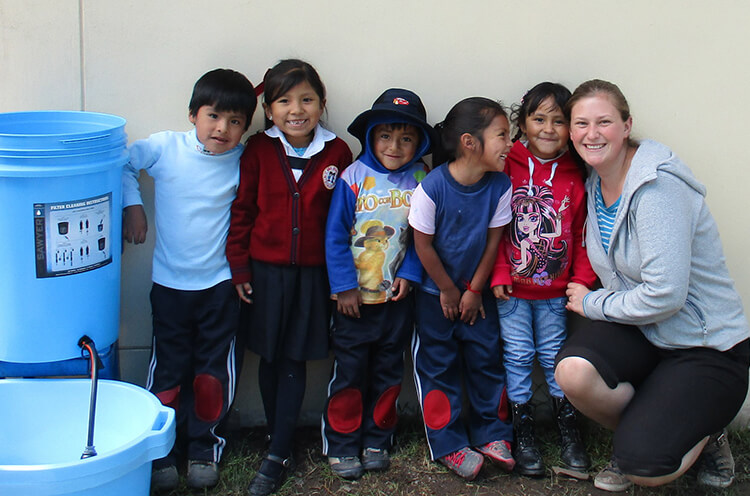
Tasks for this project include scouting locations—like schools and communities—that are in need of clean water, documenting the installation and use of the water filters, creating promotional materials to raise funds for buying more filters, and also demonstrating how to use and clean the filter for ongoing use.
Opportunities are available all year long and volunteers can combine different projects for no extra cost. Participants also have the opportunity to learn Spanish, with 20 hours of classes per week. The volunteer house is in a safe and central location, and accommodations include shared bedroom and bathroom, Wi-Fi, a well-equipped kitchen, rooftop terrace, and more. Opportunities to lodge with a host family are also available.
For how long has your organization been working in Cusco?
We are fully operational since 2014
How many programs do you offer in the region?
We offer 6 projects next to the Water Filter installations.
Teaching English, Kindergarten, Sports, Special Education, Dog
Shelter and Art Project.
I’d love to hear more about the Water Filters program! Could you tell me more about it?
The water quality in Peru is unfortunately not good. The tap water contains a lot of bacteria, and is not suitable to drink. For tourists, this is an avoidable obstacle. But that is not so easy for the local population. Buying bottled water is a cost that is a problem for many local households.
Also in schools and other institutions there is seldom access to clean drinking water.
In 2016 we started a fundraiser for buying water filters. Later on we acquired some more filters. Up to now, we ́ve installed around 50 water filters. Mostly in the Sacred Valley (in and around Calca) and Cusco. This upcoming weekend we will brief volunteers on how to install a water filter.
Then we hope to get things going in the upcoming weeks again. We still have 25 filters, but we will soon likely need more filters. We also need a clear and accessible presentation of the importance of clean water.
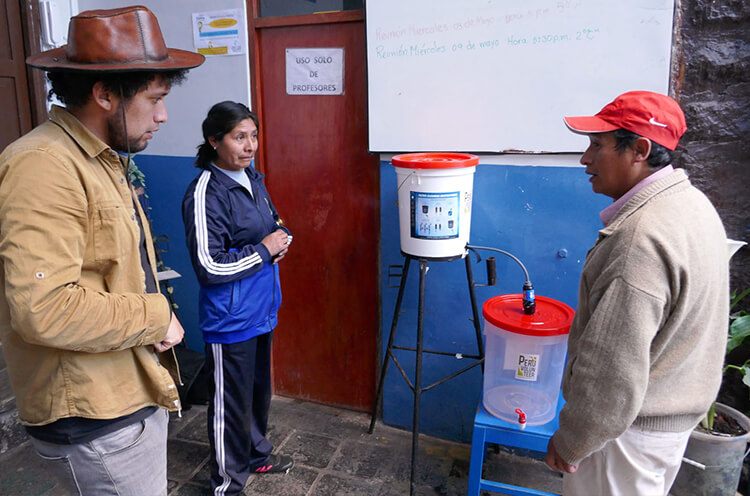
Why is access to clean water sometimes difficult in the Andean region of Peru?
The water from the tap contains bacteria. The mountain water, potentially clean, gets polluted upstream by farmers, people and organizations. As you never know what happens upstream, and there is a lack of informing and regulation.
How many workshops and filters stations have you provided?
We have installed around 50 filters.
Volunteering for this specific project, what specific tasks and cultural interaction is involved?
It’s not a constant project, but we can hopefully turn it into a regular activity. The project can be as versatile as a volunteer can make it.
Scouting of the places where necessity is high—for this work a decent
Spanish is required.
Arranging the moment of installation, and the place to install.
Give a workshop about the importance of clean water and the maintenance of the filter.
Do a check-up (or schedule one for the next volunteer) on the use and maintenance of the filter.
What do your volunteers often say is their favorite part of being involved with this Water Filters project?
It very actively and directly helps out the local population with a delicate and important matter.
Price: From $527
Min commitment: 4 weeks
Where: Cusco and surrounding areas
Volunteer
FairMail has been improving the lives of underprivileged teenagers in Peru since 2006. The mission of the organization is for all adolescents to have the opportunity to educate and develop themselves creatively and professionally—and they achieve this through the art of photography.
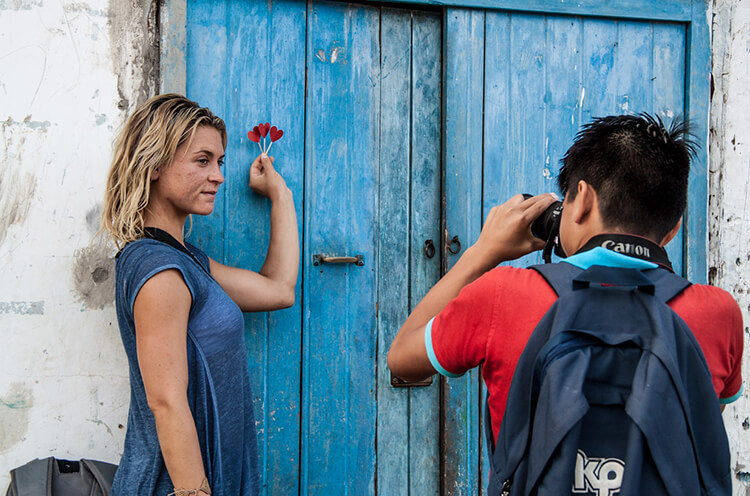
The concept is simple. First, free photography classes are held for teens in Peru who would not have otherwise had access to such classes. During this time they learn the elements of photography, different techniques, and spend time practicing taking photos. Next, their best photos are sold through FairMail on fair trade, high-quality greeting cards. Finally, 60 percent of profits go right back to the teen who shot the photo, who can then use their earnings to finance their housing and higher education.
There are three ways that people can contribute to this project. One is to buy fair trade greeting cards. By buying these cards, rather than the generic ones at local chain stores, they help encourage teens to unleash their creativity while supporting their professional development. The second is to embark on a photography excursion, where travelers accompany teens on an adventure to a beautiful, remote Peruvian landscape and take photos together. The third option is to volunteer, with opportunities to be a photography teacher, social ability trainer, graphic designer, or english teacher. Intermediate spanish required to volunteer.
For how long have you been active in Peru?
FairMail was founded in 2006 by Dutch social entrepreneurs Janneke Smeulders and Peter den Hond. The whole idea behind FairMail was born while Janneke was volunteering in El Milagro, a very poor neighborhood of Trujillo, home of the city landfill. Here, an entire community (children included) survives by separating waste and re-selling it for a few cents a bag. Working conditions are inhumane, they breath toxic fumes and are constantly exposed to the risk of getting injured. Janneke noticed that many of the volunteers used to take pictures to these kids but they would never allow them to handle their cameras, concerned that they might break. It was at this point that she decided to reverse the perspective and put the cameras in the hands of these children. The challenge was tough but not impossible: finding beauty in a place where beauty was difficult to find and capture it on camera. 13 years later, we’re still on the same mission.
Peter and Janneke ran FairMail for 12 years and in 2018 my partner Kira and I took over. Kira and I met in 2015—we were both FairMail volunteers.
What is your impact on the community you work with?
Over 13 years, the 42 photographers that have joined the project have collectively earned over 125.000 Euros and sold over 3 million cards. The photographers receive 60% of the profit that we make from the sales of the cards and they invest it in 3 funds: education, clothing and support to the family. In addition, FairMail also provides healthcare for the photographers and direct family members.
Besides providing economic support for their studies and their families, FairMail also sees to their personal growth by providing counselling and training on multiple levels. We collaborate with local psychologists, we organize creative workshops, we give English and sex education classes and much more.
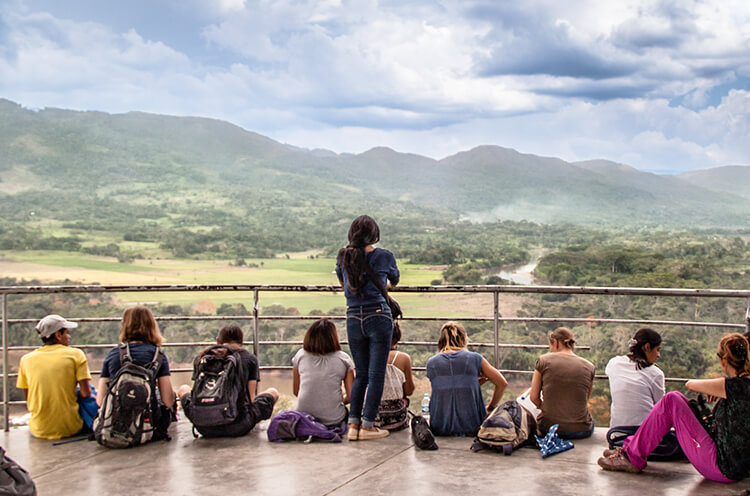
Could you tell us more about the social enterprise model and how does that apply to FairMail?
Social enterprises can take many forms, FairMail is a for-profit social enterprise and as such, we have both business and social goals.
Our business goal is to keep the company healthy so that we can keep sharing with our photographers the highest possible percentage of the profit (currently 60%) that we make from the sales of their pictures. We generate income opportunities for our photographers so that they can invest the money in their education. In other words, we make social change in a financially sustainable way.
Our social goals are embedded in our mission, which is to say:
Providing for the education of the photographers as a way to fight child labor in Peru and offering them better chances for their professional growth.
Support the photographers in their personal growth by offering psychological counselling, creative workshops, English classes, photography trips, financial advice and sex education.
Raise awareness of the role of social enterprises and of the impact that
they have in the communities where they operate
As many social enterprises, we do not depend on philanthropy and we
can sustain ourselves over the long term.
Do you have any success stories you would like to share with us?
Sure! We have several, but when asked to share one, we like to share Gabriel’s story. Gabriel is now 20 years old and he left FairMail last year (all photographers leave the program when they turn 19, but they keep receiving the earnings from the sales of their cards as long as their cards sell). As a child, he lived with his mother and his siblings in the Andes, then they moved to Trujillo in search for better life conditions. Adjusting to life in a big city wasn’t easy and Gabriel ended up singing at road junctions to earn some money. Since his family couldn’t provide for him, he was put in a boy home where he spent the rest of his childhood and almost all his teenage years. He went to school, and successfully graduated from high school. He joined FairMail in 2013 and he has been, without any doubt, one of the most successful photographers we’ve ever had. He has earned over $4000 USD(and counting!) and with this money he paid and he’s still paying for his studies (currently on his 3rd year of communication sciences). He’s also member the most prestigious photo school in Trujillo and he’s also working as a freelance photographer with two former FairMail photographers. He keeps coming to Sunday classes because he just loves being in FairMail and helping out the younger photographers. He’s such a role model!
On top of this, I’ve noticed you also offer Volunteering at Fairmail? Could you tell me more about it?
In FairMail we offer a year-round volunteering program in our production center in Huanchaco. We welcome volunteers with different profiles: photographers, film makers, marketing experts and social workers. We require a minimum stay of six weeks. The volunteers’ tasks range from planning and leading our photography sessions, to rating the pictures taken by our photographers. Volunteers for us are an incredible asset, their impact goes well beyond the practical help during the photo sessions: it’s cultural growth and source of inspiration for our photographers. We offer volunteers the possibly to stay in our beautiful front-ocean apartment for a very reasonable price, to minimize the costs of their stay. They are also always welcome to join our photography trips in Peru with the photographers.
Finally, I’d love to hear more about your sustainable trip, how does that work?
Twice a year (January and August) FairMail organizes sustainable photography trips in beautiful and unexplored areas of Peru. We invite to the trips anyone who’s up for an adventure off the beaten path and wants to experience first-hand what life in Peru is really like. Our trips are sustainable for 2 main reasons:
Included in the price that travelers pay to join the trip, there is a contribution for one of our teenage photographers. This means that thanks to them, one of our photographers will have the chance to come to the trip and be able to take new pictures and earn money for his/her education.
When it comes to accommodation, food and transport, we only support local businesses to maximize social and economic benefits for local communities. Unlike regular tour operators that don’t have any positive impact on the residents, we keep the interests of the communities we visit at heart.
Price: free
Min commitment: 6 weeks
Where: Huanchaco, Trujillo, Peru
Volunteer
Volunteer HQ was formed in 2007 by Executive Director Dan Radcliffe, after returning to his home country of New Zealand following a volunteer trip in Kenya. He loved his experience and the meaningful relationships he developed with the people of the community. However, he felt that the program, like many others he found online, was far too expensive given the true cost.
In opening Volunteer HQ, he envisioned making a volunteer program that is affordable to all. He has since brought that vision to life and now has 108,850 volunteers across 50 destinations in Africa, Asia, South America, Central America, North America, the Carribean, and the Pacific.
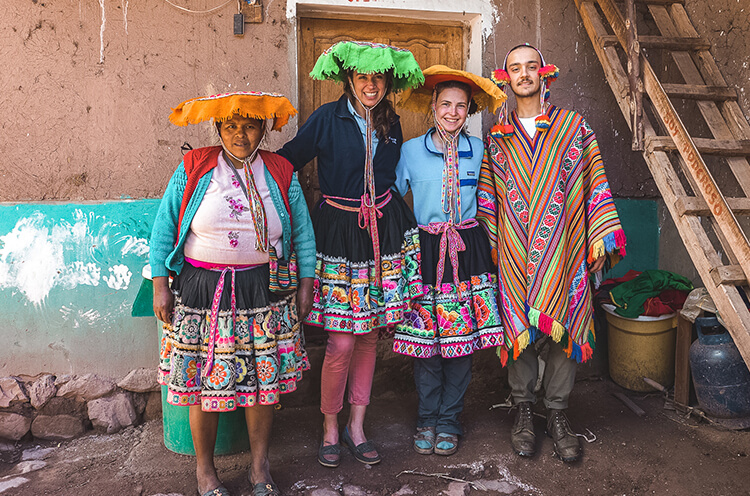
One program, and one of the longest standing at Volunteer HQ, is located in Cusco. Here, volunteers can choose from 10 projects across Cusco and the surrounding Andean valleys. Options include teaching, childcare, medical, construction, eco-agriculture conservation, and jungle conservation.
The eco-agriculture program is exciting for anyone who loves nature and farming. Volunteers journey into the cloud forests in the high jungles of the Andes to help local coffee, tea, and cacao farmers adopt efficient and sustainable farming practices. Tasks can vary depending on the time of year, but typically include clearing out land, weeding, harvesting, tilling fields, and planting seeds. This is a great opportunity to connect with the local village and help establish ecological practices.
No matter the program, volunteers are provided with training, 24/7 in-country support, airport pick up, orientation, placement, accommodation, meals, and discounts on language lessons.
For how long has your organization been working in Cusco?
Cusco is one of the longest running IVHQ programs in South America, having first opened in 2009.
How many programs do you offer in the region?
There’s a huge variety in Cusco with 10 different projects available. Volunteers can choose from Childcare, Special Needs Care, Construction & Renovation, Eco-Agriculture Conservation, Jungle Conservation, Teaching English, Medical, Andean Immersion, Animal Care and a special Holiday Experience project over the Christmas and New Year period. Volunteers can also complete a Spanish Service Learning program while volunteering, which enables them to earn course credit towards their qualifications.
I’d love to hear more about eco-agricultural conservation! How would you describe it in one or two sentences?
It’s all about helping local tea, coffee and cacao farmers with their daily tasks, while also developing and implementing efficient and sustainable practices. Volunteers use a combination of traditional farming methods and contemporary approaches that keeps the farming authentic, while also future-proofing and maximizing their operation.
What’s a typical day at the farm like?
It really depends on the time of year. You could be planting seeds, tilling fields, harvesting, weeding or clearing land for new crops. Whatever it is, volunteers can expect to be challenged by physical work that can be hard but is always rewarding! Volunteers work with local farmers, so you’ll have that supervision, as well as a great insight to life in the community.
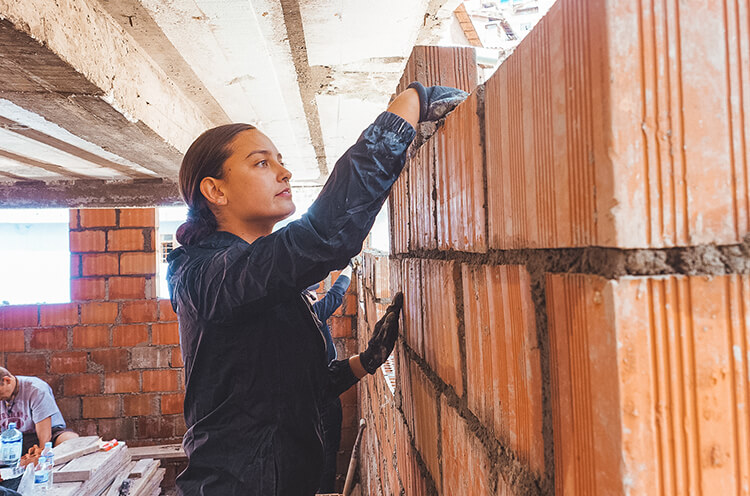
What do your volunteers often say is their favorite part of being involved with this community farm program?
The project is designed to be hands-on and challenging. Volunteers are expected to be physically fit, and because it’s based in high up in the Andes some of the work can be demanding, but that makes it rewarding. You’ll work up a sweat, but you’ll get to see the tangible results of your hard work.
In what ways has Volunteer HQ made a positive impact on this farming community?
This is a new project, so the impact is still to come—the first volunteers start on the project next month. However, IVHQ helps more than 1,000 people travel to Cusco to make a difference every year.
In 2017, IVHQ volunteers in Cusco made a positive impact through:
The IVHQ system is designed to help volunteers to make the biggest impact they can. Volunteers boost local economies by paying for accommodation and meals in the communities they are based in. They also help to pay for the employment of local staff in hosting and accommodating them, as well as the tourist dollars they spend.
Volunteers can also make a huge impact through their work. For example, on tea plantations, a farmer can harvest around US$5 worth of tea leaves per day. Every volunteer who contributes to this work increases the amount local families earn, which then goes towards basic needs such as education and food.
Do you have any favorite stories from any volunteering experiences that you would like to share with us?
IVHQ’s Cusco program has played host to a huge variety of volunteers including solo travelers, volunteers on their honeymoon and parents volunteering with their children.
Favorite stories tend to revolve around the impact that volunteers are able to have while they’re on their programs. They may have bought clothes for children, built a medical center or helped someone with special needs—these examples of achieving things never grow old!
The other thing that stands out in feedback is how rewarded volunteers feel. They selflessly go abroad to help others, but in the act of doing it, they get so much joy in return. People are amazed by how satisfying volunteering is—and that’s on top of how much difference they make too!
What do volunteers have to gain from working so closely with farmers from the Cusco region?
The learning volunteers get from local farmers is immense—some of these families have been farming in the area for hundreds of years, so they have incredible knowledge and are enthusiastic about sharing their techniques and experience.
Not only that, but volunteers get a direct link into the local community. The way of life in the community is still very traditional, so it’s a unique opportunity to get an immersive cultural experience. The locals are vibrant and enthusiastic, and eager to learn about other lifestyles too, so the cultural exchange that happens is another enjoyable aspect of the program.
Price: From $310
Min commitment: 1 week
Where: Cusco and surrounding areas
Volunteer
Add deeper meaning to your surf trip by volunteering alongside the local residents in Peru. Give back with projects related to community outreach, environmental health, and entrepreneurship empowerment.
Skateboarding is more than a recreational activity. Concrete Jungle Foundation uses skateboarding as a tool to teach life skills and self-empowerment to underprivileged youth in Trujillo, Peru and across the globe. Providing free skateparks and classes is at the core, while volunteer teachers and project managers keep the positivity rolling.
Transform lives with the gift of renewable energy. Volunteer to build wind turbines to help rural communities gain access to clean, reliable energy where traditional electricity is not accessible.
Haku Tours duals as a local travel company and nonprofit organization. Proceeds from the tour are recycled back into the local community. A food tasting tour and shanty town tour are among the many options.
Don’t hesitate to contact us for any help planning your own volunteer trip to Peru.



Email: [email protected]
Sign up to receive our newsletter for great articles, stunning photos, and special deals.